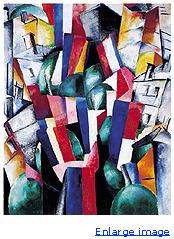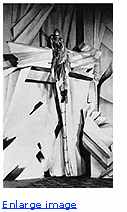








Order the catalogue
 Of solid social
status (as were most of the Amazons), Exter traveled
constantly between the Ukraine, Russia, France, and Italy,
and served as an important emissary between the Russian
avant-garde and the latest movements in Western Europe.
Indeed, the very titles of her paintings, such as
Venice, 1915, emphasize her main points of
geographical and cultural commitment. While maintaining a
sincere interest in indigenous folk art, especially
Ukrainian embroidery, Exter investigated the concepts of
Cubism, Futurism, and Simultanism before reaching
abstraction, a momentum that resulted in her magnificent
non-objective paintings of 1917-18.
Of solid social
status (as were most of the Amazons), Exter traveled
constantly between the Ukraine, Russia, France, and Italy,
and served as an important emissary between the Russian
avant-garde and the latest movements in Western Europe.
Indeed, the very titles of her paintings, such as
Venice, 1915, emphasize her main points of
geographical and cultural commitment. While maintaining a
sincere interest in indigenous folk art, especially
Ukrainian embroidery, Exter investigated the concepts of
Cubism, Futurism, and Simultanism before reaching
abstraction, a momentum that resulted in her magnificent
non-objective paintings of 1917-18.
 Exter
was an artist of many disciplines, for, while studio
painting remained her favorite medium, she also used the
book, cinema, ceramics, and especially the theater as
vehicles for her experiments–to a considerable degree
Exter can be regarded as Russia's most radical stage
designer of the 1910s. Along with Popova and Stepanova, she
contributed to the landmark 5 x 5 = 25 exhibition
held in Moscow in 1921, a conclusive event at which the
artists proposed that studio painting had run its course
and that industrial design should take over its creative
role. On this level Exter's abstract paintings may be
regarded as laboratory exercises in form, color, texture,
and rhythm that contain potential resolutions for
applications to stage, textile, and book design.
Exter
was an artist of many disciplines, for, while studio
painting remained her favorite medium, she also used the
book, cinema, ceramics, and especially the theater as
vehicles for her experiments–to a considerable degree
Exter can be regarded as Russia's most radical stage
designer of the 1910s. Along with Popova and Stepanova, she
contributed to the landmark 5 x 5 = 25 exhibition
held in Moscow in 1921, a conclusive event at which the
artists proposed that studio painting had run its course
and that industrial design should take over its creative
role. On this level Exter's abstract paintings may be
regarded as laboratory exercises in form, color, texture,
and rhythm that contain potential resolutions for
applications to stage, textile, and book design.Top right: City, 1913. Oil on canvas, 88.5 x 70.5 cm. Regional Picture Gallery, Vologda.